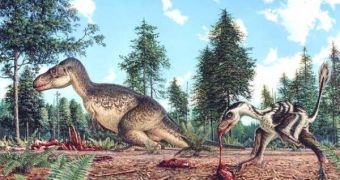New archaeological data that have emerged following digs in New Mexico and Colorado seem to infirm the hypothesis that states that the catastrophic chain of events that triggered the Cretaceous-Tertiary (K-T) extinct event killed off all dinosaur species on Earth, alongside some 70 percent of all other animals and forms of vegetation on the planet. Fossils found in the two American states seem to tell a different story, of dinosaurs that lived for at least half a million years after the extinction event. The most representative remains have been found in the Ojo Alamo Sandstone deposit, located in the San Juan Basin.
Despite the fact that the theory stating that an asteroid impact was responsible for the disappearance of dinosaurs has been around for a long time, over recent years it has come under increased criticism, as new geological and archaeological pieces of evidence seem to show that a single impact wouldn't have been enough to wipe out all of the lizards in one go. Rather, modern theories hold that a potential asteroid impact was associated with an abrupt period of climate change, as well as with an increased volcanic activity, which most likely covered the skies and led to an accelerated cooling of the global climate.
Detailed investigations of the bones recovered from the deposit, along with careful estimates on the ages of the rocks surrounding them have revealed the fact that dinosaurs lived on for about 500,000 years after the K-T boundary, which is believed to have taken place approximately 65 million years ago. “This is a controversial conclusion, and many paleontologists will remain skeptical,” LiveScience quotes David Polly, an editor for the journal Palaeontologia Electronica, as saying. The publication has hosted in its pages a new scientific study, conducted by US Geological Survey lead researcher Jim Fassett, from Santa Fe, New Mexico.
“The great difficulty with this hypothesis – that these are the remains of dinosaurs that survived – is ruling out the possibility that the bones date from before the extinction. After being killed and deposited in sands and muds, it is possible for bones to be exhumed by rivers and then incorporated into younger rocks,” Fassett explains. However, by investigating minute characteristics of the rocks around the fossils, including their magnetic polarity, the team has learned that the clues “independently indicate that they [the bones] do indeed post-date the extinction.”
Another evidence that the expert has presented in the study is the fact that the archeology team uncovered 34 bone fragments belonging to a single hadrosaurus. If the fossils had been buried before the K-T boundary, and then dug up and buried again in younger rocks, then this cache of bones would have been spread over miles and would not have remained in a single location. “One thing is certain. If dinosaurs did survive, they were not as widespread as they were before the end of the Cretaceous and did not persist for long,” Polly concludes.

 14 DAY TRIAL //
14 DAY TRIAL //